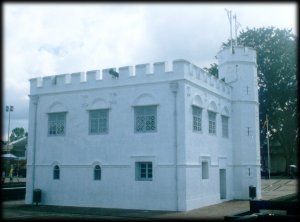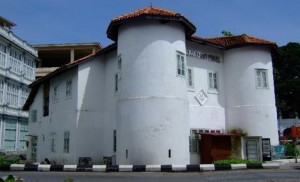 |
| Sarawak Steamship Building |
1. Sarawak Steamship Building
Built in 1930, this was previously the office and warehouse of the Sarawak Steamship Company. It is restored and houses a restaurant, fast food outlet and a convenience store.
2. Square Tower
Built in 1879 as a detention camp for prisoners, later was converted into a fortress and then a dance hall. Today it is a multimedia information center and video theater providing information on Sarawak's tourist attractions.
This 1931 building stands out majestically with its imposing neo-classical style and impressive Corinthian columns. In contrast to its ornate facade with semi-circular arches, ornamental columns capitals and friezes, the back of the building is plain and unadorned. Deep parapet walls of plain design hide the pitched root. A colonnaded portico serves as a corridor in front of the building. This will soon be converted into the Sarawak Art Museum.
Constructed in 1886, the building was meant to serve as a fort in an emergency. Instead it became the Dispensary and was then used by the Labour Department until 1980. It now houses a section of the Judiciary department. The Round Tower was strategically located to provide an excellent view of the town.
Originally used as the medical headquarter, was one of the first public buildings of more than 2 stories high. Built with concrete frames and supported by bakau (mangrove timber) piling, it also had a concrete flat roof where occupants used to lounge and watch the setting sun, as fondly recalled through numerous writings of that era. The building had been conserved and is currently used by the Museum Department as their Textile Museum.
This temple was believed to have been built by the Chinese migrants from Kalimantan, Indonesia. This temple overlooked the mouth of the Kuching stream which ran between the temple and the Old Chinese Court (present Chinese History Museum), to the Sarawak River. Numerous additions and renovation works had been done over the original structure. The dominant dragon frieze was added to the retaining wall in the early 1980s.
Across the Main Bazaar, situated across the Sarawak River, the fort was named after Ranee Margaret, the wife of Charles Brooke. Strategically perched on top of a hill, with vantage points overlooking Kuching and the river, it was the ideal sentry point for the settlement.
8. Kuching Waterfront






